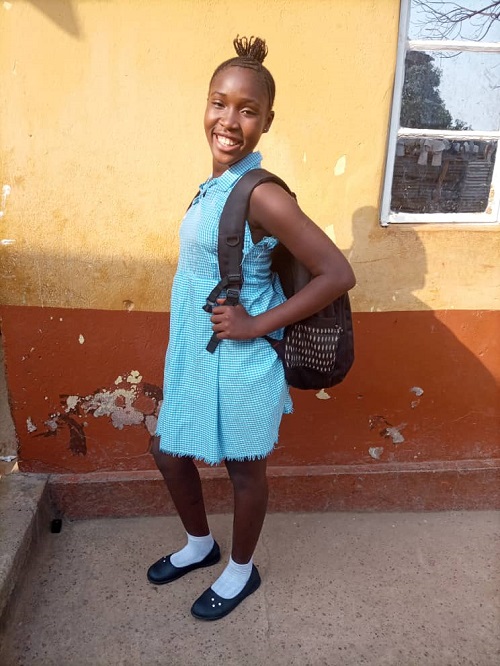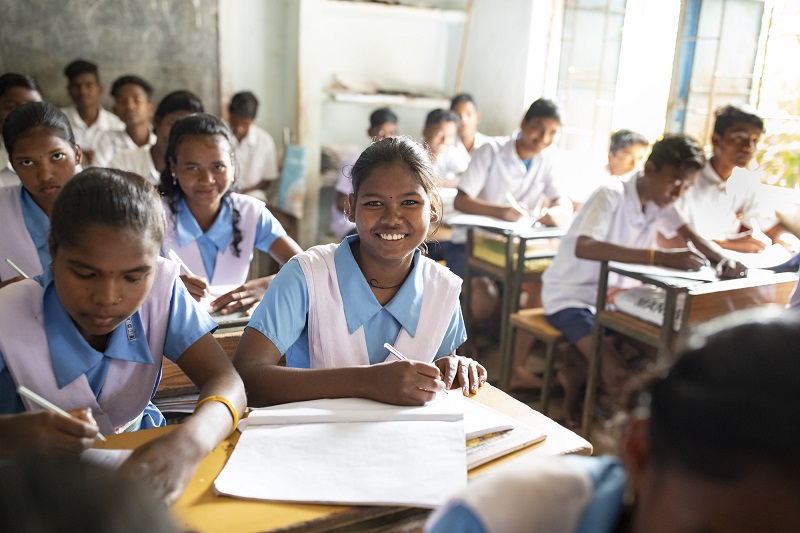Site will be
unavailable for maintenance from June. 4, 11:30 p.m., to June 5, 12:30 a.m. ET. Thank you for your
patience!
Breaking down barriers to educating girls
Posted on 10/07/2021

Feremusu on her way to school again. “Education is not only for boys, but for girls too!” she says.
At age 12, Feremusu thought she might never go back to school.
Where she lives in rural Koinadugu District, Sierra Leone, many people do not believe in educating girls past a certain age. Her aunt and primary caregiver, Sunkarie, used to be one of them. “I wanted to go to school like my friends, but my aunt would not allow me,” Feremusu says. Instead, she was forced to drop out and help Sunkarie sell goods at the local market.
Things finally changed when Feremusu was enrolled in ChildFund’s programs and Sunkarie attended a series of positive parenting classes. “The training opened my eyes and helped me see things differently,” she admits. “Now I believe that girls have business in the classroom.” She has since enrolled Feremusu back in school, and they have both become advocates for girls’ education in their community.
Feremusu’s story is not unusual. Around the world, girls face incredible obstacles to their education. Unfortunately, many girls who find themselves in a similar situation aren’t so lucky.
Girls' education: Challenges & solutions
Primary among the barriers to girls’ education are poverty, gender-based violence and social and cultural attitudes about the roles of women and girls. Like Feremusu, many girls in developing communities fall victim to their families’ belief that it is a waste of money to send girls to secondary or even primary school. Others cave to cultural or financial pressure to get married young. Still others must drop out to help provide for their families. That was the case for Gita.
The summer of 2019 was one of the hottest on record. Even so, most of the kids in Gita’s town in Keonjhar District, India, were going back to school after their usual March-May break, buzzing with the excitement of entering a new grade, meeting new teachers and making new friends.
Gita herself was supposed to be entering the eighth grade, but she couldn’t. Both of her parents had just fallen seriously ill with malaria. The family could barely afford food, so medical treatment was out of the question. As the only girl in her family, not to mention the oldest, Gita had no choice but to drop out of school and work in the sweltering rice fields – long days of backbreaking labor in more than 100-degree heat. She was 14.
“I wasn’t thinking about the heat,” Gita says. “I was more concerned with my parents and their health.” Her family had to survive, and her little brothers’ education was more important.
When ChildFund’s local partner organization learned about Gita’s situation, they worked to get her parents to a local hospital for treatment and get Gita back into school. Today, Gita’s parents have made a full recovery, and she’s pursuing her dream of becoming a teacher.

Gita at school.
The reality is that every child, regardless of gender, has a right to an education. Moreover, the education of girls not only helps them achieve their individual potential, but also helps to break intergenerational cycles of poverty and disadvantage. According to UNICEF, girls who receive an education are less likely to marry young and more likely to lead healthy, productive lives. They earn higher incomes, participate in the decisions that most affect them, and build better futures for themselves and their own children.
But investing in girls’ education goes beyond just keeping them in school. It’s about making sure they are safe at school and that they are equipped with all the resources they need to learn and excel at the rates of their male peers – including, in today’s world, digital resources.
The digital gap in education
Since the onset of the COVID-19 pandemic, the digital gap – between those with sufficient knowledge of and access to technology, and those without – has widened, often on gendered lines. In parts of the world where girls’ education is not prioritized, girls are often the last to gain access to the kinds of technology that have become so crucial to education from home, like smartphones, tablets and learning apps. When schools shut down and learning went virtual, many girls lost complete access to the traditional modes of learning they had depended on for their education.
Harini, a high school student in Ranga Reddy District, India, was one of those girls. “During the lockdown, I was stressed and anxious about my exams because I didn’t know how to prepare for them,” she says. “I couldn’t reach out to teachers or friends for support because all schools had been closed since March 2020.” She especially worried about her English exam, a subject she saw as critical to her success. “I used to go to a private tutor before the lockdown to study English and other subjects. Unfortunately, those classes shut down too. I was depressed because I couldn’t see any way out of the situation.”
Then Harini learned about an online training course that ChildFund India was providing to help children in the area with English communication. She went to inquire about the course, and the team gave her access to Playablo, an educational app for students in India.
It took a while to understand how to use it, but over the course of six months, “the app greatly improved my English,” Harini says. She aced her exams and has now enrolled in college.
In the future, Harini hopes she can use her education to lift her family – and others – out of poverty. “I want to build a beautiful house for my parents and help young girls like me finish their studies,” she says.
How to celebrate International Day of the Girl
Stories like Feremusu’s, Gita’s and Harini’s remind us how important it is to celebrate the progress we’ve made globally in educating girls – and acknowledge how far we still have to go.
Every year on October 11, the international community celebrates International Day of the Girl to increase awareness of gender equality and promote fair opportunities for girls. This year, here are just a few ways you can get involved in the fight to keep girls in school and connected to every opportunity they need to thrive:
•Donate to an organization that supports girls’ education globally.
•Sponsor a girl somewhere in the world who could use your encouragement and support to fuel her academic and career goals.
•Share this story with your family and friends so they can understand the importance of girls’ education, challenges and solutions. Tell them why every girl, just like every boy, deserves the chance to stay in school and make her dreams a reality.
Loading...


